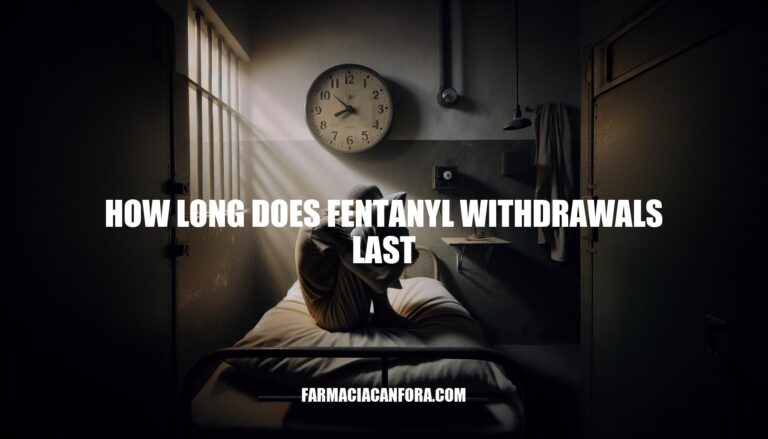Fentanyl addiction is a severe and growing issue due to the drug’s high potency and risk of overdose. Understanding the duration of fentanyl withdrawals is crucial for those seeking recovery, as withdrawal symptoms can be intense and challenging. Typically, withdrawal symptoms begin within 6-12 hours of the last dose, peak around 1-3 days, and can last up to two weeks. Addressing fentanyl addiction is vital for improving health outcomes and reducing the risk of fatal overdoses.
Symptoms of Fentanyl Withdrawals
During fentanyl withdrawal, individuals experience a range of physical and psychological symptoms.
Physical symptoms include:
- Muscle and bone pain
- Diarrhea and vomiting
- Nausea
- Increased heart rate (tachycardia)
- High blood pressure (hypertension)
- Sweating and chills
- Insomnia
- Increased body temperature
Psychological symptoms include:
- Anxiety
- Irritability
- Severe cravings for the drug
- Restlessness
These symptoms can be extremely uncomfortable and challenging, making it difficult for individuals to manage withdrawal without medical support.
Initial Onset of Fentanyl Withdrawals
Fentanyl withdrawal symptoms typically begin 6 to 12 hours after the last dose. The initial onset of symptoms can include muscle aches, anxiety, and sweating. These symptoms usually peak around 36 to 72 hours after the last dose.
Peak Period of Fentanyl Withdrawals
Fentanyl withdrawal symptoms typically peak in intensity between 36 to 72 hours after the last dose. This peak period usually lasts for about 1 to 3 days.
Duration of Fentanyl Withdrawals
Fentanyl withdrawal typically begins within 6-12 hours after the last dose. The acute phase peaks between 36-72 hours and usually subsides within 7-10 days. However, some symptoms may persist for a few weeks.
Variations based on individual factors and usage patterns:
- Duration and frequency of use: Longer and more frequent use can lead to more prolonged and severe withdrawal symptoms.
- Dosage: Higher doses can result in more intense withdrawal symptoms.
- Individual health: Underlying physical and mental health conditions can affect the severity and duration of withdrawal.
- Type of fentanyl: Immediate-release formulations may cause withdrawal symptoms to appear and peak faster.
Factors Influencing the Duration of Fentanyl Withdrawals
Here are the key factors that can affect the duration of fentanyl withdrawals:
- Dosage: Higher doses of fentanyl can lead to more severe and prolonged withdrawal symptoms.
- Duration of Use: Long-term use of fentanyl can result in a longer withdrawal period.
- Frequency of Use: Frequent use increases the body’s dependence on the drug, extending the withdrawal timeline.
- Method of Administration: Methods that deliver fentanyl more quickly to the bloodstream (e.g., injection) can intensify withdrawal symptoms.
- Individual Health Conditions: Underlying physical and mental health conditions can exacerbate withdrawal symptoms and prolong the process.
Managing Fentanyl Withdrawals
Medical Interventions
-
Medications:
- Methadone: Reduces withdrawal symptoms and cravings.
- Buprenorphine: Eases withdrawal symptoms and reduces cravings.
- Naltrexone: Blocks opioid receptors to prevent relapse.
- Clonidine: Manages symptoms like anxiety, agitation, and muscle aches.
-
Medical Detox:
- Supervised detoxification in a medical facility to ensure safety and comfort.
Therapeutic Interventions
-
Behavioral Therapy:
- Cognitive Behavioral Therapy (CBT): Helps manage cravings and develop coping strategies.
- Contingency Management: Provides incentives for maintaining sobriety.
-
Support Groups:
- Participation in groups like Narcotics Anonymous (NA) for peer support and accountability.
-
Counseling:
- Individual or group counseling to address underlying issues and emotional support.
-
Lifestyle Changes:
- Regular exercise, healthy diet, and adequate sleep to support overall well-being.
These strategies can significantly help manage the duration and severity of fentanyl withdrawals.
Fentanyl Withdrawal Symptoms
Fentanyl withdrawal symptoms can begin within 6-12 hours after the last dose and peak between 36-72 hours, lasting up to two weeks.
Physical symptoms include:
- Muscle pain
- Diarrhea
- Nausea
- Increased heart rate
- High blood pressure
- Sweating
- In insomnia
- Increased body temperature
Psychological symptoms include:
- Anxiety
- Irritability
- Severe cravings
- Restlessness
Individual factors such as dosage, duration of use, frequency of use, method of administration, and underlying health conditions can affect the duration and severity of withdrawal.
Managing Fentanyl Withdrawal Symptoms
Medical interventions like medications (methadone, buprenorphine, naltrexone, clonidine) and medical detox can help manage symptoms. Therapeutic interventions like behavioral therapy, support groups, counseling, and lifestyle changes can also aid in recovery.
Seeking professional help is crucial to effectively manage fentanyl withdrawals and reduce the risk of fatal overdoses.


